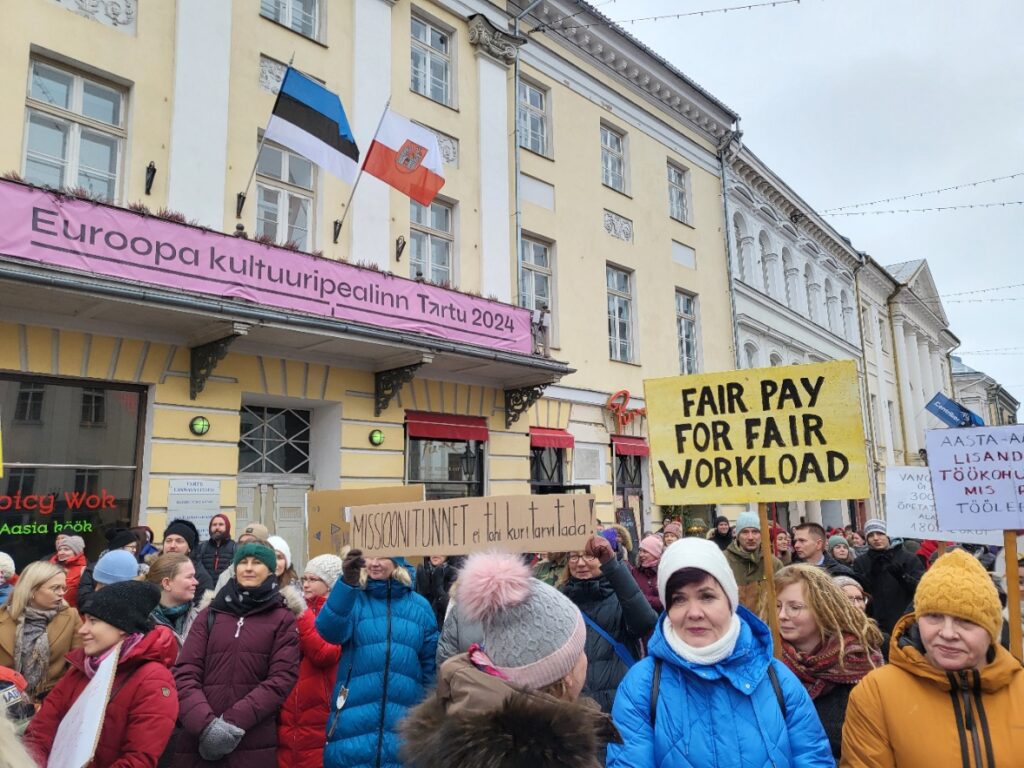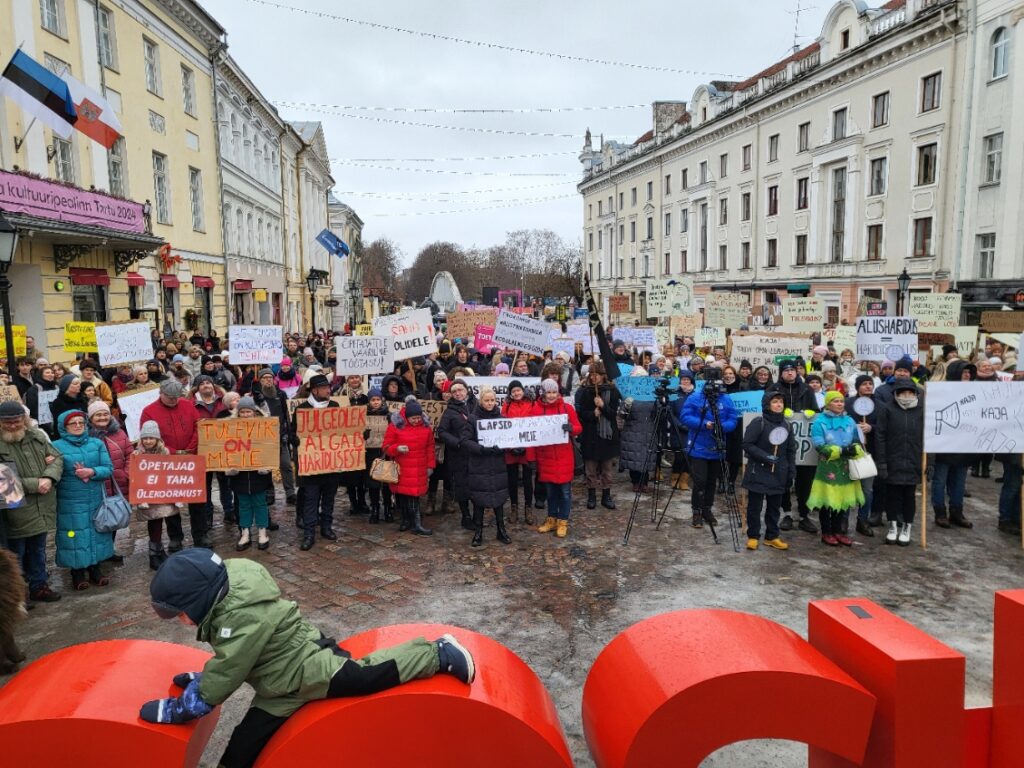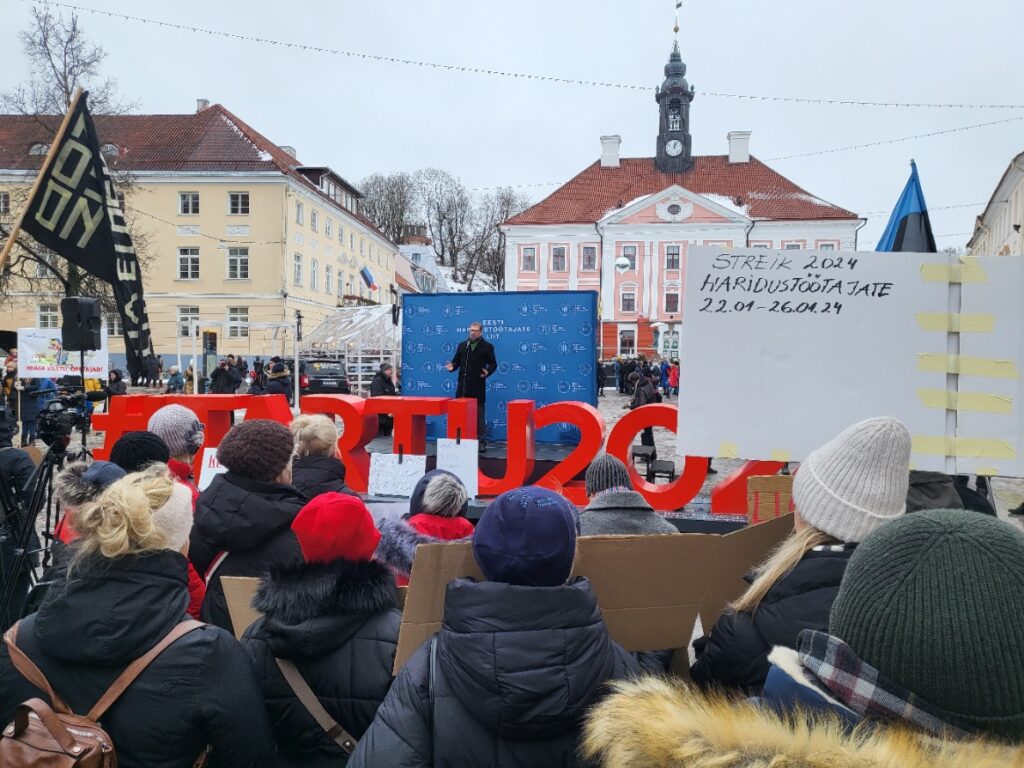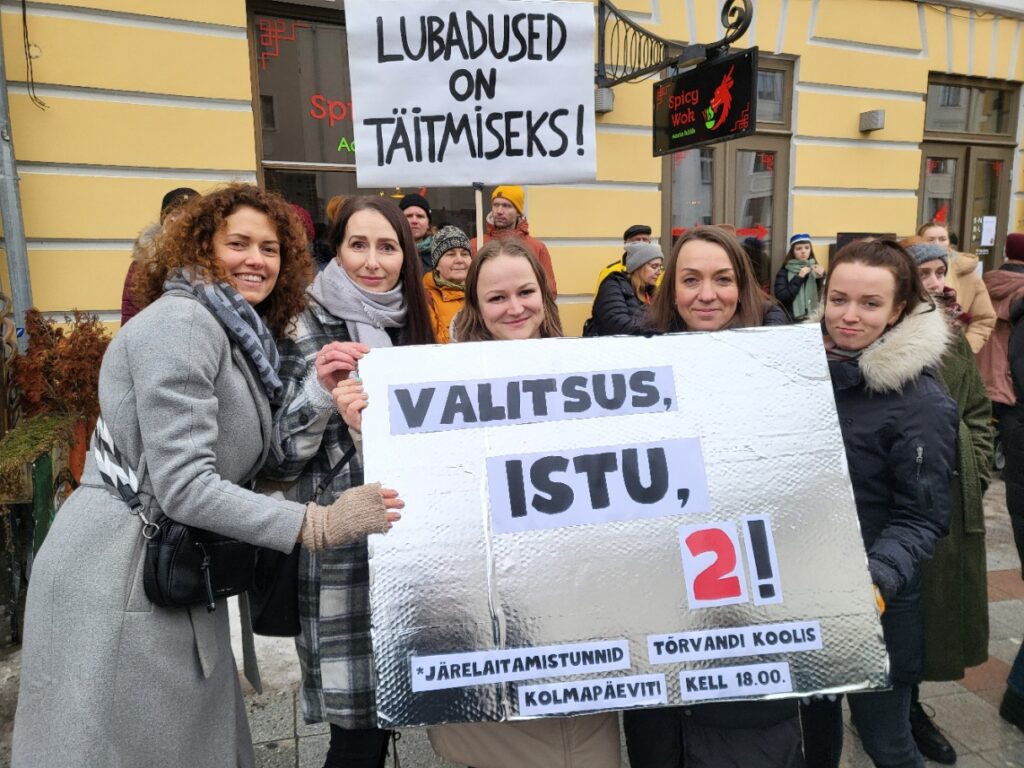Many teachers in Estonia earn less than €2,000 a month before tax – despite the EU country’s poster child status in Pisa test results; low pay and overtime were the main reasons why more than 10,000 teachers walked out for nine consecutive days before the seven-day strike, which was unique in both its duration and scale, ended on 30 January.
On 24 January, around 500 people gathered at the town hall square in the southern Estonian town of Tartu. Despite being surrounded by ‘Tartu 2024’ banners and posters – the European Capital of Culture activities began in the country’s second largest city last week – the teachers weren’t interested in joining in the festivities. Instead, they protested for fair pay and against heavy workloads.
In freezing temperatures, school principals, students and union representatives spoke from a makeshift stage.
“Good work needs fair pay,” “Politicians, keep your promises,” “Defence starts with education” and other slogans could be read on placards.

For history teacher Alla Vinitsenko, the promised pay rise of just €34 a month was the last straw – especially in the context of Estonia’s runaway inflation, which, at one point, was twice the EU average.
“With inflation, €34 does not even cover a trip to the supermarket,” Vinitsenko said. “Working hours and expectations should be in line with the salary, the income of the teacher. At the moment it’s not enough for what is expected of us. It’s an illusion that we work 35 hours a week; there’s also a poster that says ’35 hours will be done by Wednesday’.”

Seven days of strikes
Vinitsenko is one of about 25,000 teachers in Estonia, about two per cent of the total population of 1.3 million.
In September, Estonia’s largest teachers’ union, the Union of the Estonian Education Workers, demanded an average gross minimum wage of €1,950 per month for teachers in general education schools, which would have meant an 11 per cent pay rise.
After this was rejected by the government, the unionm lowered its demand to €1,835. This would have required at least €10.8 million.
After the government failed to reach an agreement on 26 January, the strike and protests continued in Tallinn on 29 January.

On 30 January, the government made a new counter-proposal: €5.7 million would be invested in teachers’ salaries – only about half of what the union had originally demanded.
A spokesman for the union, Janno Isat, said he understood that some teachers were disappointed that their salaries would only increase by €17 a month. But he stressed that for the first time in Estonia’s history, there’s now a long-term collective bargaining process for education workers.
“Tuesday’s negotiations with the education ministry were quite intense,” Isat said. “It’s not the ideal result, but it’s a much better starting point compared with November.”
The impact on students
Over the course of seven working days, around 70 per cent of all teachers walked off the job. As a result, tens of thousands of children and teenagers from kindergarten to grade 12 – and many of their parents – had to stay home.
Angelina Roosimägi and Tähe Helk Rosenvald, both in their 12th and final year at Jaan Poska Gymnasium, showed their solidarity with their country’s educators at last week’s protest at the Tartu Town Hall Square.

“There are no classes, no homework, no school at all. We’ve just been home without teachers. I think they deserve as much as anyone with a degree and even more, because they are the ones who pass on knowledge,” they said, adding that they “miss all the good teachers” and that the government should “put more money into the education system”.
The government infighting over pay rise
At the heart of the dispute between the three parties in the ruling coalition was the question of who should pay for the union’s compromise demand of €10.8 million. Estonia’s prime minister, Kaja Kallas, and the finance minister, Mart Võrklaev, said the responsibility lay with the education ministry.
The education minister, Kristina Kallas, and the foreign minister, Margus Tsahkna, both members of the Eesti 200 party, insisted that the government should accept the teachers’ compromise offer (because the education minister understands the far-reaching consequences of the strike for pupils’ education, the ministry said on 29 January).
The education ministry, on the other hand, claimed it did not have the necessary funds and asked other ministries for co-financing, successfully raising a total of €5.7 million.

Despite failing to achieve their initial goal of an 11 per cent pay rise for their constituents, the union spokesman Janno Isat said teachers deserved more than just more money.
“It’s not about the €10.8 million, it’s more about the lack of respect and the general attitude of the government towards teachers,” Isat said. “Most teachers just don’t feel valued anymore. The messages coming from the government have been very arrogant.”
The history of unions in Estonia
According to Isat, about one in four teachers in Estonia is a member of a trade union. Membership comes with health benefits, legal aid and discounts at sports clubs, among other things.
The striking teachers also receive financial support from the strike fund from the sixth day onwards – 50 per cent of their wages retroactively, he said.
“During the Soviet era, you had to be a member of a trade union, but many left when Estonia regained its independence,” Isat noted.
“Membership has a bit of a Soviet-era feel to it; many don’t want to join because they don’t understand why it’s necessary. In Finland, over 90 per cent of teachers are union members. We are not very good at organising ourselves, we only come together when there is a real crisis. So trade unions are still a bit of a novelty in Estonia. But it’s growing, a little bit every year.”

What will happen next?
In 1992, more than 90 per cent of workers were union members; now the figure is just six per cent, one of the lowest union densities of any OECD country.
Estonia’s first major teachers’ strike is over, but negotiations aren’t over yet – on 19 February, the unions and the education ministry will begin collective bargaining to gradually raise teachers’ average gross monthly salary to 120 per cent of the national average by 2027.
History teacher Alla Vinitsenko said she had been ready to strike for weeks. But the collective agreement with the city council forced her to return to class after just three days.
“If we don’t stand up for our rights now, it will go on and on and on,” she said. “I took part in a strike ten years ago and unfortunately we are still here and the problems are still the same.”

